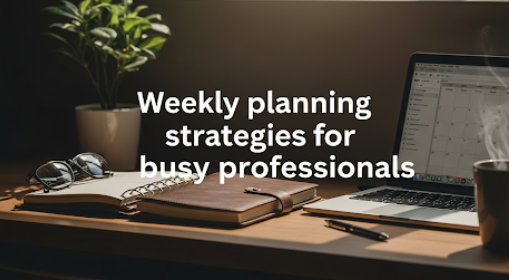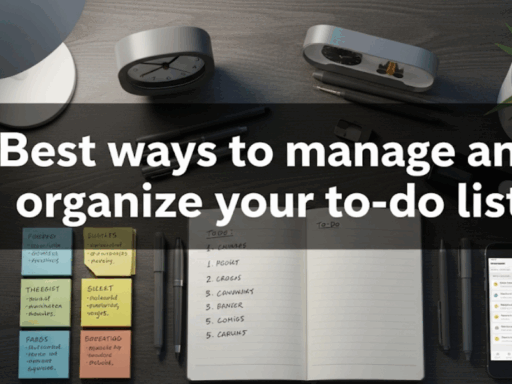A Complete Guide to a More Productive Life and Daily Organization Tips for Maximum Efficiency
It just never feels like there are enough hours in the day, does it? You’re not alone. There are millions of people who fight to keep all their workplaces organized and perform effectively. The good news is, when you implement the correct daily organization strategies, clutter becomes clear instruction and you no longer need more time to see better results.
This guide covers everything you need to know about getting organized, how real people do it and the science that explains why others don’t love organizing as much as you do. No matter who you are, whether a busy student, working professional or someone who just needs to meet more demands in a day — these tips will help you manage your day and do more without all the stress.
Clean Up Your Act: Why Daily Organization Proves More Important Than You Realize
It is more than an issue of wasting time due to poor organization. Some studies suggest that disorganized people spend one to two hours per day looking for things. In numbers, that totals 44 hours a year, which is more than one working week! In addition to lost time, it causes stress, reduced concentration and even hurts your work output in professional personas or personal relationships.
You will see all these benefits when you build strong organizational habits:
- Reduced stress and anxiety
- Better work-life balance
- Improved decision-making abilities
- Faster time to better output
- More control and sense of accomplishment
Jump Start Your Day: Organizational Morning Rituals
The Magic of Waking Up at the Same Time
Your circadian rhythm is your body’s internal clock. Waking up at the same time each day (even on the weekends) makes you feel more awake and alert as well. After two weeks you will start to notice the benefits of waking up at the same time each day.
Create a Morning Launch Sequence
Your day is like a rocket in that way — it needs a specific sequence to launch. Create a 30–60 minute morning ritual, where you get your head and body ready for the day:
- Drink a glass of water right when you wake up — Hydrate ASAP
- Check-in with your daily priorities — Take 5 minutes to scan your calendar and review your most important projects for the day
- Get your work area ready — be it your desk, kitchen, or car
- Set three daily intentions — choose three things you want to get done today
The Night-Before Advantage
In fact, the most productive people actually begin their day the night before. Take 10-15 minutes every evening to get ready for the next day:
- Lay out your clothes
- Pack your bag or briefcase
- Prepare lunch or snacks
- Review tomorrow’s schedule
- Declutter main living/working areas
Control Your Time: Master Time Management Techniques that Work
The Time Blocking Method
Use time blocking, not a simple to-do list. Set aside certain blocks of time for various tasks in your day. Here’s how it can be done effectively:
Step 1: Brain Dump — Everything and anything that occurs to you, jot it down without considering the order or what is more important than another.
Step 2: Categorize — Group similar tasks together (emails, phone calls, creative work, administrative tasks)
Step 3: Time Estimate — Make a close estimation of effort in hours (WARNING: Add buffer time to the prediction)
Step 4: Block & Schedule — Make sure each task or set of tasks is scheduled into specific time slots on your calendar
Priority Matrix: Focus Only On What Matters And Let Everything Else Wait
Each task is different. Here is a simple priority matrix you should follow to determine what requires your attention:
| Do First | Schedule |
|---|---|
| Crises, emergencies | Prevention, planning |
| Delegate | Eliminate |
|---|---|
| Interruptions, some calls | Time wasters, excessive TV |
The Two-Minute Rule
If it will only take you two minutes or less to get something done, do that right away instead of adding it to your list. That way, small jobs do not build up and get out of hand later.
Examples of two-minute tasks:
- Reply to a quick email
- File a document
- Make a brief phone call
- Return something to where it belongs
- Schedule an appointment
If You Can Conquer Technology, You Can Conquer Anything — Organizing Your Digital World
Email Management Strategies
Without a system, the email trap can start to feel suffocating. Try these proven techniques:
The Only Handle It Once (OHIO) Method
The second you open an email, DECIDE to either:
- Delete it
- Reply to it
- Forward it
- File it
- Schedule time to address it later
Inbox Zero Approach:
- Set specific email checking times (at most 2 to 3 times a day)
- Turn off email notifications
- Use filters and folders or labels to sort messages
- Unsubscribe ruthlessly from unnecessary lists
Digital File Organization
Create a systematic folder structure on your computer:
Documents/
├── Work/
│ ├── Projects/
│ ├── Meetings/
│ └── Reports/
├── Personal/
│ └── Finance, Health, Travel/
└── Archive/
└── 2024/ (and previous years)
File Naming Convention: YYYY-MM-DD_Category_Description
(e.g., 2024-08-10_Meeting_QuarterlyReview)
App Organization for Maximum Efficiency
Group smartphone apps by function rather than alphabetically:
- Main Screen: Daily-use apps (Calendar, Messages, Phone, Camera)
- Productivity Folder: Email, documents, project management
- Utilities: Calculator, weather, maps
- Entertainment Folder: Games, social media, streaming apps
Organizing Your Physical Space: Productivity is Greatly Influenced by the Environment You Work In
The 5S Method for Any Space
The 5S method is a manufacturing technique that can be applied to any space:
- Sort: Remove unnecessary items
- Set in order: Make a place for everything that makes sense
- Shine: Keep it clean and attractive
- Standardize: Create consistent procedures
- Sustain: Make it a habit
Desk Organization Essentials
The way your workspace is organized affects your ability to focus and get things done:
The Desktop Rule
If you use something daily, have it on your desktop:
- Computer/laptop
- Notebook and pen
- Water bottle
- A project you’re currently working on
Storage Solutions:
- Drawer organizers for small things
- Filing system for important documents
- Keep everything you reach for often within arm’s reach
- Keep reference materials close by, but not on your desk
Kitchen Organization for Busy Lives
This makes meal prep that much faster and less hectic!
Zone System:
- Prep Zone: Cutting boards, knives, mixing bowls
- Cooking Zone: Pots, pans, spatulas near the stove
- Cleaning Area: Dish soap, sponges, towels near the sink
- Storage Station: Tupperware, wraps & bags
Weekly Meal Prep:
- Plan Sunday meal prep for the week
- Create a well-organized, store-by-store shopping list
- Prep ingredients ahead of time (wash vegetables, marinate proteins)
- Prepare bulk staples (rice, quinoa, vegetables)
Systems for Task Management: Experiment and Find What Works
The Getting Things Done (GTD) System
GTD is a comprehensive system of task and commitment management created by David Allen:
Five Core Steps:
- Capture — Write down everything that has your attention
- Clarify — Decide what each item means and what action is required
- Organize — Put items in appropriate lists and folders
- Reflect — Review your system regularly
- Engage — Take action with confidence
The Pomodoro Technique
Work in short intervals followed by brief breaks:
- Choose a task to work on
- Set a timer for 25 minutes
- Focus on the task at hand
- When it rings, take a 5-minute break
- Take a 15-30 minute break after four pomodoros
Benefits:
- Improves focus and concentration
- Reduces mental fatigue
- Makes large projects feel manageable
- Prevents burnout with regular breaks
Simple To-Do List Optimization
If complex systems don’t appeal to you, optimize your basic to-do list:
Apply the 1-3-5 Rule
Each day, aim to complete:
- 1 Big Thing — Major task or project
- 3 Medium Tasks — Moderate time or complexity
- 5 Small Tasks — Quick or routine tasks
Daily Review Questions:
- What are the 3 most important things I need to get done today?
- Which obstacles could prevent me from completing them?
- What items can I delegate or eliminate?
- How will I reward myself when I finish my to-do list?
High Performance Advanced Organizational Methods
Weekly and Monthly Planning Sessions
Start thinking in larger terms rather than planning day by day:
Weekly Review (30 minutes every Sunday)
- Review the previous week’s accomplishments
- Identify what worked well and what didn’t
- Plan the upcoming week’s priorities
- Schedule important tasks and appointments
- Update your project lists
Monthly Planning Session (90 minutes at month end)
- Assess progress toward longer-term goals
- Adjust strategies and systems
- Plan major projects and deadlines
- Review and update your organizational systems
- Create a monthly roadmap of priorities
Energy Management vs. Time Management
We all function on natural energy cycles, not all being morning people.
Discover Your Peak Hours
Keep an hour-by-hour log of your energy for a week. Most people have:
- High energy: Morning or early afternoon
- Moderate energy: Late morning or early afternoon
- Low energy: Mid-afternoon or evening
Match Tasks to Energy:
- High Energy: Creative work, deep problem solving, critical thinking
- Moderate Energy: Routine tasks, checking emails, administrative duties
- Low Energy: Tidying up, filing, casual communication
Batch Processing for Maximum Efficiency
Complete similar tasks together to minimize mental switching costs.
Examples of Batch Processing:
- Process all emails at once
- Make all phone calls together
- Cook multiple meals at the same time
- Handle all administrative tasks together
- Process all invoices or paperwork together

Building Sustainable Organization Habits
The 1% Improvement Rule
Rather than trying to completely transform your life, focus on small, achievable changes:
- Wake up 5 minutes earlier each week until you reach your desired time
- Declutter one small space each day (one drawer, one shelf, one folder)
- Add one new organizational habit per month
- Prepare for tomorrow in 10 minutes each night
Creating Environmental Cues
Design your environment to make organization easier.
Visual Reminders:
- Keep your to-do list where you’ll see it first thing
- Place healthy snacks at eye level in your fridge
- Lay workout clothes out near your bed
- Use colorful labels and folders for filing
Remove Friction:
- Put frequently used items in convenient places
- Create low-decision systems
- Automate recurring tasks whenever possible
- Eliminate unnecessary steps from your routines
The Power of Weekly Resets
Set aside time each week to reset everything:
Sunday Reset Checklist (45-60 minutes):
- [ ] Clean and tidy main living areas
- [ ] Do laundry and put it away
- [ ] Buy groceries & meal prep
- [ ] Review calendar for the next week
- [ ] Update to-do lists and project statuses
- [ ] Prepare work outfits for the week
- [ ] Clean out bag/purse/briefcase
Measuring Your Organization Success
Track Key Metrics
Monitor these metrics to quantify your organizational improvement:
Time-Based Metrics:
- Hours spent looking for lost items
- Number of tasks completed per day
- Time from task creation to completion
- Morning routine duration
Stress-Based Metrics:
- Frequency of feeling overwhelmed
- Quality of sleep
- Missed deadlines or appointments
- Overall life satisfaction (rated on a 1–10 scale)
Regular System Reviews
Conduct monthly reviews to keep your organizational system effective:
Questions to Ask:
- How did my organization improve this month?
- Which systems failed me?
- What took longer than expected and why?
- What new tools or techniques should I test next month?
- How can I improve my existing systems?
Your Path to Organized Success
Staying organized daily is not about perfection, but about having systems in place that will simplify your life and keep you focused on what matters most. Start by focusing on one or two techniques rather than attempting to incorporate them all at once. After all, the best system is the one you will actually use regularly.
Change takes time and developing new habits requires patience. It takes 66 days on average to create a new habit, so be patient with yourself as you build new routines. Celebrate small wins, and don’t be afraid to adapt systems to work for you.
Your organized life is waiting. Pick one strategy from this guide and get started right away. Tomorrow, add another. Before you know it, you will have transformed daily chaos into calm, productive efficiency.
By following these daily organization tips, you will be prepared to live more effectively with less stress. Organization is a long-term investment — the benefits you experience by learning to organize your life today will last for years through increased productivity, peace of mind, and personal fulfillment.




